Hold the cardboard on a side that is not exposed to light. The light will hit the cardboard, reflect off its surface and illuminate the dark side of the bouquet. On one side the bouquet will be illuminated by natural light, and on the other side you will sort of catch the main light and refract it onto the composition. This will not only show the hue and texture of the flowers without distortion, but also allow you to view each petal.
The art of photographing flowers: A fool-proof guide for taking pictures of bouquets on your phone
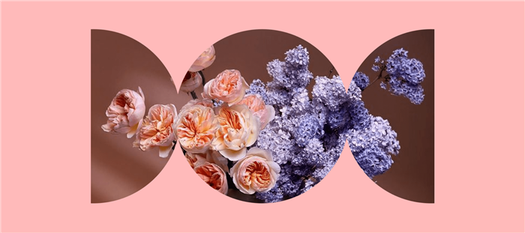
To beautifully photograph flowers that people will want to buy, you need to properly prepare for the photoshoot: decide on the objective, choose a place and time, buy everything necessary. Then you can proceed to the photoshoot itself: set up your phone, choose a background, build a harmonious frame. Such photos can then be posted on your website, on Instagram, and other social media platforms.
In this article Pavel Polkov, a florist teacher, will tell you more about how to photograph flowers to convey the beauty, shape, composition, size and mood of the bouquet.
Define the photoshoot objective
To photograph flowers beautifully, first you need to define the purpose of the photoshoot. This will determine how much space the bouquet will occupy in the photo, what will be in the background, whether you need several photos of flowers from different angles or one will be enough.
For example, you want to beautifully photograph a bouquet of flowers for your online store, Instagram* or other social media, so that people will look at it and want to give it to their loved ones. To make people want to buy your bouquet, they need to see what flowers the bouquet consists of, understand its shape and size, and feel what emotions the flowers will bring the owner.
To deal with this task, it is better to place the flowers so that they occupy most of the photo. Tilt the flowers forward so that the composition of the bouquet is clearly visible. Put a model next to it, that will help understand the size of the bouquet and convey its mood.
If you just take a picture of an amazing bouquet of roses for Instagram* without considering that people make a decision to purchase when looking at the photo, you can mislead the customer.
For example, if the photo does not convey the size of the bouquet, the customer may think that the prices in the store are inflated, and leave without a purchase.


If the customer does not see all the flowers in the picture of the bouquet, he can also leave without buying it. The client may decide that the price of the bouquet is too high, because he estimates the cost of the bouquet by the flowers he sees, and does not take into account those that are not in the frame.
Or vice versa: the client may think that the invisible part of the bouquet has the same flowers as the one he sees. And when he receives the flowers he will be disappointed if this is not the case. Therefore, it is important to arrange the bouquet so that its entire composition can be read.


It is good if a florist looks in the mirror when making a bouquet and tries to figure out how flowers will look in the photo: which flower should be added, highlighted or removed, so that people will want to buy the bouquet just by looking at its picture.
POSiFLORA helps florists make bouquets faster and always informs you about sales

With the POSiFLORA photo catalog, you can quickly find a flower in the system, or create and update the database. Each flower name on the catalog is accompanied with an image. That way, a florist won’t mistake one row for another as is the case with Excel spreadsheets, and that will ensure accurate accounting.
Try POSiFLORA
Generally, people do not give each other flowers, but the mood that comes with the bouquet. Therefore, it is important to photograph the flowers correctly so that the picture conveys the emotions that the florist put into the bouquet. The background, the lighting, the model and the accessories will help with this.
If the picture shows just flowers, it dims in comparison with photos of bouquets that convey the mood.

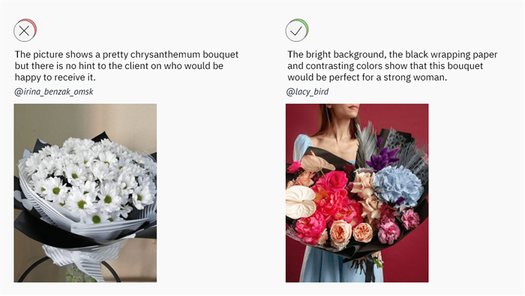
Fleurs du mal: how artist Taryn Simon constructs political bouquets
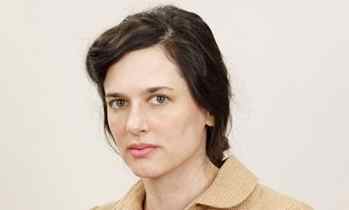
A t New York City’s Gagosian gallery on Thursday afternoon, Taryn Simon has just finished installing her new show Paperwork and the Will of Capital, an exhibition of 36 large-scale photographs of floral bouquets, alongside a dozen sculptures of concrete plinths with flower pressings. On until 26 March, the show is Simon’s American debut of the completed work. (She showed the pressed flowers and plinths at the Venice Biennale’s Arsenale last June.)
Simon is much loved in the New York art world, both for the gravitas of her work, which is excerpted in magazines such as Vogue and the New Yorker, but also for the glamorous figure she cuts. Later that evening, the gallery was packed with the artist’s high-profile friends – Bono, Wes Anderson, Marina Abramović.
Though Simon’s work is highly conceptual and often quite humorless, it is also strangely relatable. As an artist, she possesses the uncanny ability to catalogue the mundane objects and scenes of our lives while gently pointing to the fraught nature of what they symbolize politically.
In her latest exhibit, she has turned her eye to flowers.
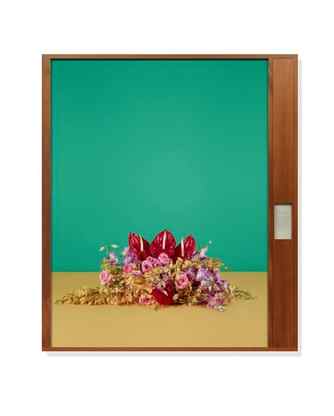
For the last three years, Simon has immersed herself in the literature surrounding flowers, beginning with the work of George Sinclair, a British imperial gardener of the 19th century. The flower as a symbolic entity intrigued her – its feminine associations of beauty, as well as its visual and tactile qualities. But it was, as with much of Simon’s work, the more political element that dominated her fixation.
The more Simon looked, the more she saw how with every major accord, treaty, contract, decree or agreement – where world leaders and corporations met in a room together to have their picture taken – there existed a flower arrangement made to accompany this historic event. One floral arrangement in an expressionless photo of Hitler, Mussolini and Chamberlain, taken at the 1938 Munich conference, first caught her attention. Simon says the banality of the gathering just seemed perfectly encapsulated in the flowers, which were in a shallow bowl in the middle of a coffee table.
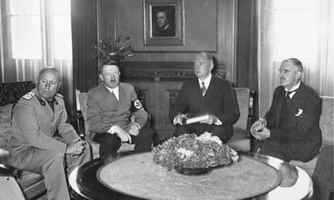
Working with a botanist, Simon began to piece together the floral components of arrangements – from the roughly arranged palm fronds made for a 2000 agreement between Fidel Castro and Hugo Chávez, to the pile of pink lilies present the day a Non-Proliferation of Nuclear Weapons treaty was signed between Russia, Ukraine, the US and the UK in 1994. She sourced her bouquets from the famous Aalsmeer Flower Auction in the Netherlands, where 20m flowers are sold each week.
“I’m now so aware of the modifications flowers have undergone,” says Simon.
“If you go to the bodega, you’ll see how a flower has had its stamen and ovaries removed so it can survive longer. Also, you learn about the slow elimination of certain flowers from the global market because of their fragility. Or conversely, how rose is so robust, it can survive practically anywhere. Our desire associated with [the rose] is linked and encouraged by market intentions.”
The resulting photographs are flat and devoid of sentiment. They express nothing, which is her point. Simon’s photographs are artfully staged, well-lit productions. Her work has never been interested in what spontaneity or emotion the lens can capture.
To her, the power of the photograph is in understanding how quickly an image can convey information, but also of how simple it is for our eyes to be deceived.
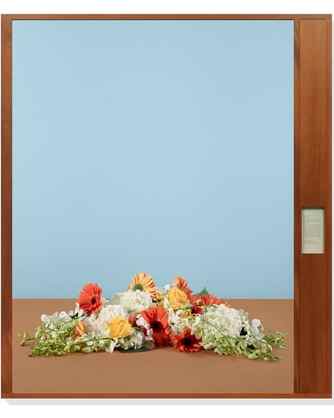
Her earliest work, The Innocents (2002), was a collection of portraits of men who had been wrongfully convicted and imprisoned. In each, the subject is placed within a setting that contextualizes this event in his life, be it a bar where he had an alibi or the scene of the crime. They are cold and unsentimental, the images don’t evoke the kind of empathy one might expect to feel when confronted with such injustice. These men don’t look guilty, but neither do they appear innocent. This, however, is exactly Simon’s point: the criminal justice system uses photography to manipulate our perception. Here, she won’t.
And yet, despite such impersonal aesthetic outcomes, Simon’s own boundaries and constraints create work that is unique to her – history, after all, is narrative, too. Her reinterpretation of the significance of these flower arrangements is partly why they are so compelling: this is her act of revision.
“Everyone at my studio kept laughing at me,” Simon admits. “For years, I’ve just been looking at all those photos as though those things are listening. A photo eliminates sounds, and so many other elements, so we are forced to imagine. And I am imagining it representing a certain innocence and purity.”
Camera Settings for Photo Light Box
When I am working with a large arrangement of flowers, I always shoot for maximum DOF; I use no less than f8. But if I am working with a single flower, I use shallow DOF to create the ethereal look.
- On the tripod: ISO 100 to 200, f-stop 7.1 to 11, aperture priority mode (If you are comfortable with manual mode, go for it), matrix metering
- Handheld: ISO 400 to 800, f-stop 5.6 to 8, shutter speed manageable to avoid shaking, matrix metering
With your flowers arranged on or in front of the light box, shoot your first series of bracketed images (3 or 5). The first one should be +2 stop overexposed, the second at +1, the third at +3 stops. These settings are not written in stone. Use them as a baseline and tweak them as you see fit.
Your white background is rendered gray when you properly expose, so you must use exposure compensation. If you look at the histogram, most of the data should be towards the right half of the graph.
Post-Processing in Photoshop
You can combine your bracketed sequence to transparency in Photoshop, but leave out the last frame if it’s too washed out. In either Adobe Camera Raw or Lightroom, adjust the white balance, apply lens corrections, and remove chromatic aberrations. Then sync the settings with the rest of your bracketed sequence.
Open all of the bracketed images in Photoshop as layers. Starting with the lightest frame on the bottom and the darkest frame on top, select all the layers and auto-align them. Using layer masks, bring in the details of the flowers from the rest of the layers.
You can also experiment with color profiles and with different plugins like NIK Color Effex, Topaz Impressions, or Alien Skin’s Exposure 4. If you’re interested in textures, you can apply them at this point. When you’re ready to print, consider metallic paper for an especially luminescent final product.
For Outdoor Flower Photography
As nature photographers, I understand that shooting indoors may not be very appealing to many. You can still achieve similar results while shooting outdoors. Use the sky as a light box – the bright light behind the flowers shines through, revealing the translucency that you wouldn’t otherwise see.
Here are a few examples:
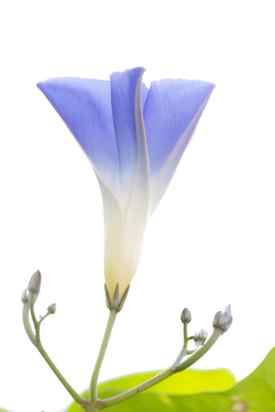
Outdoor creative flower photography
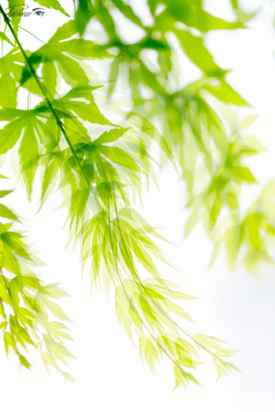
Outdoor photography of back lit leaves
Now that you know the flower photography secrets of creating jaw-dropping artistic fine art photos, all you have to do is give it a go. Feel free to share you own tips and techniques in the comments below.
About Author Padma Inguva
Padma Inguva is a flower photographer who first picked up a camera to capture the fruits of her labor in her New Jersey garden. Her curiosity and perfectionism have driven her to spend thousands of hours in shooting and processing floral portraits and she loves sharing her gained insights with others. Her Meetups, webinars, workshops, and mentoring sessions cover topics like equipment selection, composition, lighting, and post processing. Her hope is that through photography, others can learn to see the beauty in little things and create for themselves an oasis in this constantly demanding life.





